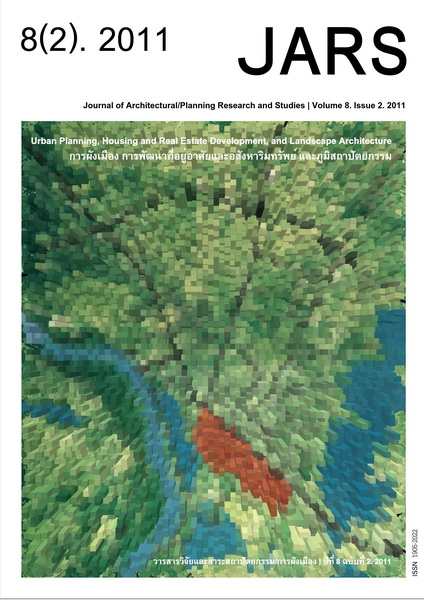Innovation in the Real Estate Business
Main Article Content
Abstract
This article aims to study the concept of innovation in the real estate business through an analysis and
review of the data from secondary academic sources and 410 real estate projects, sourced from the internet,
by the top 10 developers in 2010. It also attempts to point out the various aspects of innovation in the real
estate business, both in housing and high-rise building projects. The results reflected that concept of ‘innovation’
has been extensively applied to both process and product innovation, encompassing a range of aspects including
function, service, design and construction technology, and facilities. In summary, product innovation is very
important for creating market opportunities for developers, while process innovation gives added support to
product innovation and the improvement of the productivity of an organization. Furthermore, the Innovation
concept provides substantial benefits, especially to small and medium development firms, in developing a niche
market.
Downloads
Article Details

This work is licensed under a Creative Commons Attribution-NonCommercial-NoDerivatives 4.0 International License.
All material is licensed under the terms of the Creative Commons Attribution 4.0 International (CC-BY-NC-ND 4.0) License, unless otherwise stated. As such, authors are free to share, copy, and redistribute the material in any medium or format. The authors must give appropriate credit, provide a link to the license, and indicate if changes were made. The authors may do so in any reasonable manner, but not in any way that suggests the licensor endorses you or your use. The authors may not use the material for commercial purposes. If the authors remix, transform, or build upon the material, they may not distribute the modified material, unless permission is obtained from JARS. Final, accepted versions of the paper may be posted on third party repositories, provided appropriate acknowledgement to the original source is clearly noted.
References
Bender, K. W., Cedeño, J. E., Cirone, J. F., Klaus, K. P., Leahey, L. C., & Menyhert, T. D., et al. (2000). Process innovation—Case studies of critical success factors. Engineering Management Journal, 12(4), 17-24.
Blayse, A. M., & Manley, K. (2004). Key influences on construction innovation. Construction Innovation, 4(3), 143-154.
Boonlert, B. (2010). สูตรลับการสร้างเงินในอสังหาริมทรัพย์ [The secret regulations making money in real estate]. Bangkok, Thailand: T & K.
Chang, S. C., & Lee, M. S. (2008). The linkage between knowledge accumulation capability and organizational innovation. Journal of Knowledge Management, 12(1), 3-20.
Chunsheng, B., & Dapeng, M. (2007). Study on new product development: Based on the process innovation of organization. Canadian Social Science, 3(3), 27-34.
Cefis, E., & Marsili, O. (2005). A matter of life and death: Innovation and firm survival. Oxford Journals: Industrial and Corporate Change, 14(6), 1167-1192.
Daft, R. L. (2007). Understanding the theory and design of organizations. USA: Thomson.
Damanpour, F. (1990). Innovation effectiveness, adoption and organization performance. UK: John Wiley & Sons.
Drucker, P. F. (1985). The innovator and entrepreneur. NY: Harper & Row Publishers.
George, M. L., James, W., & Kimberly, W. H. (2005). Fast innovation: Achieving superior differentiation, speed to market, and increased profitability. New York: McGraw- Hill.
Ghassan, A., Beliz, O., & Carl, A. (2010). Facilitating innovation in construction: Directions and implications for research and policy. Construction Innovation, 10(4), 374-394.
Gofin, F., & Mitchell, R. (2005). Innovation management: Strategy and implementation using the pentathlon framework. New York: Palgrave MacMillan.
Hall, P. (1994). Innovation, economics and evolution: Theoretical perspectives on changing technology in economic systems. New York: Harvester Wheatsheaf.
Payuhanaveechai, C. (2008). การวิเคราะห์นวัตกรรมอสังหาริมทรัพย์ [The analysis of real estate innovation]. GH Bank Housing Journal, 53(14), 66.
Peca, S. P. (2009). Real estate development and investment: A comprehensive approach. New Jersey: John Wiley & Sons.
Peiser, R. B., & Frej, A. B. (2007). Professional real estate development: The ULI guide to the business (2nd ed.) WA: Urban land institute.
Pornchokchai, S. (2011). สรุปสถานการณ์ตลาดที่อยู่อาศัย 2554 [The situation in the housing market by 2011]. Agency for real estate affairs company limited. Retrieved April 14, 2011, from http://www.area.co.th/thai/area_announce/area_anpg.php?strquey=area_announcement178.htm
Rabe, C. B. (2006). The innovation killer: How what we know limits what we can imagine -- and what smart companies are doing about it. New York: AMACOM.
Rattanaprichavej, N. (2010). ผลการดำเนินงานของวิสาหกิจขนาดกลางและขนาดย่อมจากมุมมองแนวคิดองค์การแห่งการเรียนรู้และนวัตกรรมองค์การ [Organizational performance of small and medium enterprises (SMEs) from the concepts of learning organization and organizational innovation]. Doctor of Public Administration Thesis, Graduate School of Public Administration, The National Institute of Development Administration, Bangkok, Thailand.
Real Estate Information Center. (2010). ที่อยู่อาศัยสร้างเสร็จจดทะเบียนใหม่ ในเขตกรุงเทพฯ – ปริมณฑล มกราคม-ตุลาคม ปี 2553 [The registration of dwelling in greater Bangkok Jan- Oct, 2008]. REIC Research Report. Retrieved April 14, 2011, from http://www.reic.or.th/upload/news/34026/REICResearchReport101230.pdf
Robbins, S. P., & Coulter, M. (2003). การจัดการและพฤติกรรมองค์การ [Management] (Sanguanwongwan, W., Trans). Bangkok, Thailand: Pearson Education Indochina.
Savitz, L. A., & Kaluzny, A. D. (2000). Assessing the implementation of clinical process innovations: A cross-case comparison. Journal of Healthcare Management, 45(6), 366-379.
Schermerhorn, J. R., Hunt, J. G., & Osborn, R. N. (2003). Organizational behavior. New York: John Wiley & Sons.
Steinhoff, D., & Burgess, J. F. (1989). Small business management fundamentals. USA: McGraw-Hill.
Subrahmanya, B. (2009). Nature and strategy of product innovations in SMEs: A case study-based comparative perspective of Japan and India. Innovation: Management Policy and Practice, 11(1), 104-113.
Taedullayasatit, P. (2008). การวิเคราะห์นวัตกรรมอสังหาริมทรัพย์ [The analysis of real estate innovation]. GH Bank Housing Journal, 53(14), 67-68.
Thorpe, D., Ryan, N., & Charles, M. B. (2009). Innovation and small residential builders: An Australian study. Construction Innovation: Information, Process, Management, 9(2), 184-200.
Urabe, K., Child, J., & Kagono, T. (1988). Innovation and management: International comparisons. New York: Walter de Gruyter.
Vermeulen, P. A. M. (2005). Uncovering barriers to complex incremental product innovation in small and mediumsized financial services firms. Journal of Small Business Management, 43(4), 432-452.
Weiss, P. (2004). Adoption of product and process innovations in differentiated markets: The impact of competition. Review of Industrial Organization, 23(3-4), 301-314.


